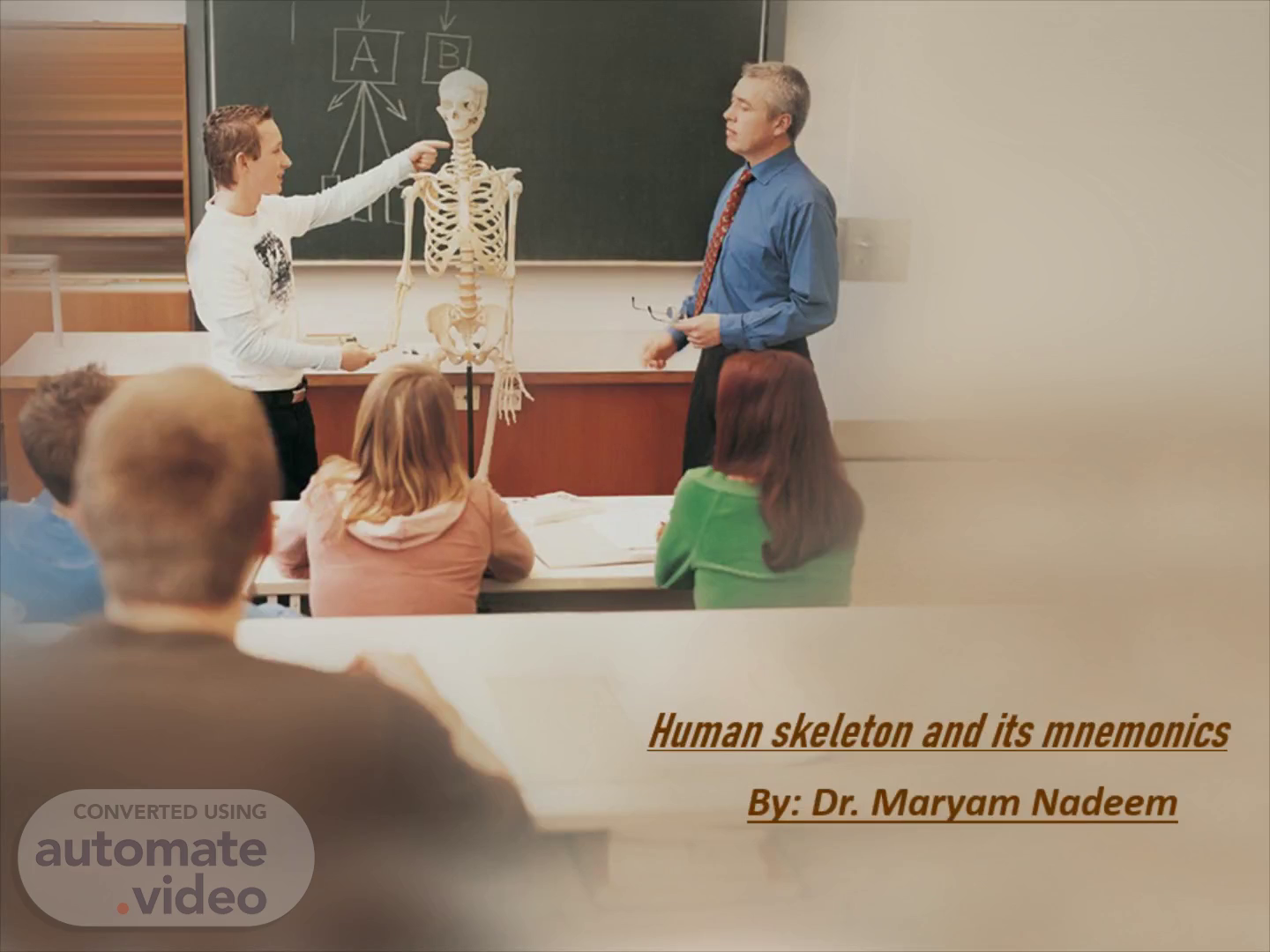
Page 1 (0s)
Human skeleton and its mnemonics. By: Dr. Maryam Nadeem.
Page 3 (1m 50s)
What are bones?. Bones are rigid bars, that are made up of connective tissues. It can be subjected to disease, and can be fractured. It can mould itself according to changes is stress and strain. Bones, despite of their hardness, are very much a living tissue. They have greater regenerative power than any other tissue of the body(except blood). These are the reservoirs of about 99% of calcium of our body. These are living tissues that are capable of growth and perform vast number of functions..
Page 4 (2m 22s)
Human skeleton. It is a f ramework of joined bones Helps to stand straight, to move, to perform any physical activity, and also aids in breathing. The adult skeleton consists of 206 bones. When we are born, we have a greater number of bones, about 275 but as time passes, many bones fuse together, and decrease in the count. Also at birth, there is a greater amount of cartilage, which is afterward replaced by bones. Over a period of about 7 years, each bone in our body is slowly replaced by a new bone. This happens by a process called Cartilaginous ossification (which involves the replacement of hyaline cartilage with bone) skeleton consists of a greater part of compact bone. This bone consists of a large number of tree-like structures called Haversian systems or osteons . (Osteon is the functional unit of bones..
Page 5 (3m 21s)
Composition of bones. Bones Bone cells Osteoblast Osteocytes Osteoclasts Extracellular matrix collagen fibers(organic substance) inorganic minerals.
Page 6 (3m 38s)
Osteoblasts are bone-forming cells. They secrete bone matrix. They are responsible for the mineralization of the bone tissue. When osteoblasts are trapped in the matrix which they have secreted, then they become osteocytes. Osteoclasts are bone reabsorbing cells. Responsible for demineralization of bone. An important role in re-modeling bone. Also, recycle the matrix. C Collagen fibers are the most abundant protein in the human body. It is a kind of fibrous connective tissue. They function as a glue in the body i.e. holds together all the body structures. Inorganic mineral crystals form rod-shaped crystals. These mineral crystals are responsible for the hardness, rigidity, and great compressive strength of bones comparable to iron and steel..
Page 7 (4m 27s)
Human skeleton. Skeleton (206 bones) Axial skeleton(80 bones) Skull(29) Sternum/chest bone(1) Appendicular skeleton(126 bones) Girdles(6) Vertebral column(26) Ribs(24) Limb bones (120).
Page 8 (4m 38s)
Axial skeleton.
Page 9 (4m 53s)
Skull (29 bones). Skull(29) Cranium(8) Facial bones(14) Hyoid bone(1) Ear ossicles(6).
Page 10 (5m 17s)
sphenoid bone(1) r. ethmoid bone(1) r.
Page 11 (5m 40s)
Facial bones(14):. Inferior conchae(2) r. Vomer bone(1) r.
Page 12 (6m 2s)
Hyoid bone(1): Ear ossicles(6):. Hyoid bone Hyoid.
Page 13 (6m 20s)
Sternum(1). The sternum is a partially T-shaped vertical bone that forms the anterior portion of the chest wall centrally . The sternum is divided anatomically into three segments: Manubrium Body xiphoid process. The sternum connects the ribs via the costal cartilages forming the anterior rib cage..
Page 14 (6m 40s)
Ribs(24).
Page 15 (7m 17s)
Vertebral column(26). anterior view cervical vertebrae (CI-C7) thoracic vertebrae (Tl-T12) lumbar vertebrae Atlas (C 1 ) T12 15 sacrum (Sl-S5) coccyx right lateral view posterior view Axis (C2) L5 sacrum coccyx.
Page 16 (7m 47s)
Appendicular skeleton.
Page 17 (8m 3s)
Girdles(6). 1:shoulder girdle(4). 2:pelvic girdle(2).
Page 18 (8m 35s)
Limb bones(120). Limbs(120) Forelimb(60) Humerus(2) Radius(2) Hindlimb(60) Femur(2) Ulna(2) Carpals(16) Metacarpals(10) Phalanges(28) Patella(2) Tibia(2) Fibula(2) Tarsals (14) Metatarsals(10) Phalanges(28).
Page 19 (8m 49s)
Forelimb(60). (a) Left humerus, anterior view Greater tuberosity Head Bicipital groove Lesser tuberosity Pectoral ridge Deltoid ridge Shaft Supracondyloid foramen Coronoid fossa Radial fossa Olecranon fossa Trochlea Lateral epicondyle Capitulum Medial epicondyle (b) Left humerus, posterior view.
Page 20 (9m 32s)
Distal phalanges Intermediate phalanges Proximal phalanges Metacarpals Carpals.
Page 21 (10m 17s)
Hindlimb(60). head greater trochanter shaft nutrient foramen lateral condyle O Encyclopædia Britannica, Inc. lines lesser trochanter — line of attachment of border of synovial membrane - line of reflection of synovial membrane — line Of attachment of fibrous capsule epiphyseal line medial condyle patellar surface.
Page 22 (11m 0s)
Patella(2). Tarsals metatarsals and phalanges(52).
Page 23 (11m 57s)
Mnemonic for cranial bones. STEP OF S PHENOID T EMPORAL E THMOID P ARIETAL O CCIPITAL F RONTAL.
Page 24 (12m 5s)
Mnemonic for facial bones. MY MANDIBLE CHEWS NINE VERY LARDE ZUCCHINI PIZZAS M AXILLA M ANDIBLE C ONCHAE N ASAL V OMER L ACRIMAL Z YGOMATIC P ALATINE.
Page 25 (12m 17s)
Mnemonic for carpal bones. SHE LOOKS TOO PRETTY TRY TO CATCH HER S CAPHOID L UNATE T RIQUETRAL P ISIFORM T REPIZIUM T REPIZIUS C APITATE H AMMATE.
Page 26 (12m 28s)
Mnemonic for tarsal bones. TRY CATCHING NAUGHTY CUTE CHICKS T ALUS C ALCANEUM N AVICULAR C UNIFORM(3) C UBOID.